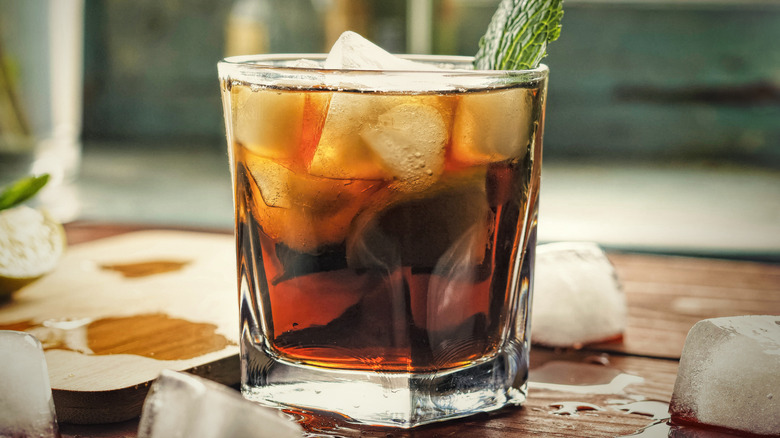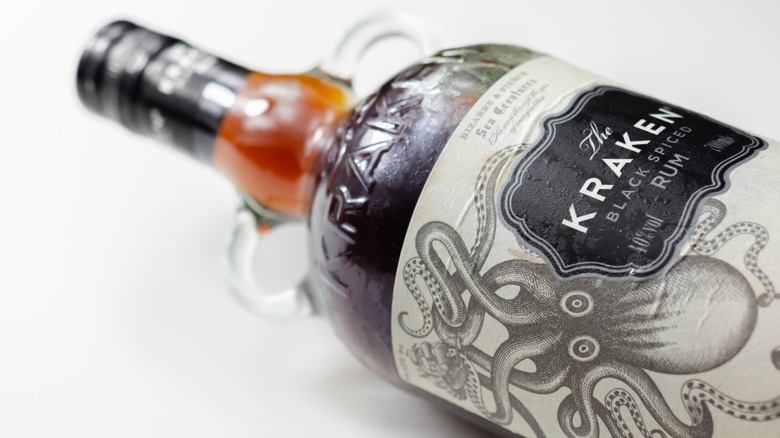Is Spiced Rum Actually Considered A Dark Rum?
Most of us are familiar with white rum, dark rum, and perhaps, even coconut or banana-flavored rum. But what about spiced rum? Does it belong in the same category as dark rum? After all, spiced rum looks darker than white rum, and most spiced rums certainly have that warm, deep flavor profile that we associate with darker rums.
So, is spiced rum just another variety of dark rum? Not necessarily. Spiced rum is a concoction crafted by infusing classic rum with spices and even artificial flavoring like caramel, vanilla, or nutmeg. This combination of ingredients not only gives spiced rum a sweeter, warming flavor that's perfect for cold winter nights and tropical beach vacations, but also contributes to its darker color.
Adding to the confusion, there's no legal definition in the liquor world for what qualifies as light or dark rum aside from simply looking at the color (you can't always trust rum labels). Therefore, while not all spiced rums are dark in nature, you might encounter a dark rum that is a spiced rum.
So next time you ask for a spiced rum cocktail, remember that while it may look darker than white rum, it's not quite the same as a the dark one. And with so many different flavors and blends available, there's no shortage of ways to enjoy this uniquely spiced spirit. Still confused? Let us break it down for you.
Unraveling the mystery of spiced rum
To understand whether your spiced rum is considered a dark rum, it helps to understand what makes it dark in the first place. The answer lies in the aging process. Dark rums undergo the longest aging process in barrels, which results in a richer, more complex flavor profile. The final product also features a deeper color and a smoother finish. Spiced rum, on the other hand, isn't necessarily aged any longer but instead gets its unique flavor profile from the addition of spices and other flavorings.
To determine once and for all what kind of rum you're drinking, it's recommended to look at the bottle's labeling for some clues. In the United States, the Alcohol and Tobacco Tax and Trade Bureau requires rums to be at least 40% ABV. If they aren't, the TTB qualifies them as flavored rums and requires distillers to include a "distinctive or fanciful product name with a statement reflecting the composition and character of the product is sufficient as class and type designation, e.g., 'Spiced Rum, Rum With Spice Flavor'."
To put this to the test, look at a bottle of Captain Morgan White Rum and Captain Morgan Spiced Gold. The latter is labeled as a spirit drink, whereas the lighter variety is referred to as Caribbean white rum (which would be the best type of rum to use for a mojito, by the way).
Dark vs. spiced rum: A battle of bold flavors
How do the two types of rum differ in taste? Dark rums tend to have a more pronounced molasses or caramel flavor and even a hint of smoke due to the aging process in charred oak barrels. Spiced rum exhibits a wide range of flavors depending on the specific spices used, but typically has a thick aroma and lighter taste. The spicy kick also usually leads to a lingering bite at the end of each sip.
Some believe that spices were originally added to help dial down the intensity of rum to make the flavor more enjoyable. In an age where rum was referred to as "kill devil" due to its incredible strength, the added spices not only helped tone down the alcohol's intensity but paired nicely with the vanilla flavors released from the oak barrels.
Looking to sample and sip both a dark and spiced rum? The Kraken's Black Spiced rum is a great go-to. Although referred to as a dark rum, you'll note the label says it's an "imported rum blended with spice, caramel, and other natural flavors."
To savor the unique flavors, make the brand's Banana Old Kraken. Mix two parts Kraken Black Spiced rum with ¼ parts banana liqueur, ¼ demerara syrup, and three dashes of Angostura bitters. Strain the mixture over ice and "unleash the Kraken" as you sip it slowly.


